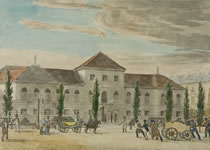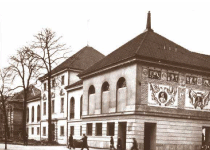 Warsaw armory. Exterio View.
Warsaw armory. Exterio View.
J. Piwarski. Color Lith. 1829.
 Wygląd Arsenału w 2 poł. lat trzydziestych XX w. (arch.)
Wygląd Arsenału w 2 poł. lat trzydziestych XX w. (arch.)
The Museum Building - The Arsenal
The Museum Building - The Arsenal The Warsaw Arsenal - the seat of the National Archaeological Museum (PMA) The Arsenal buildings were erected at Długa Street in the years 1638 - 1643 on the initiative of King Władysław IV. The buildings formed a complex around a rectangular courtyard. From the north was the main building, so-called Great Cekhauz, where weapons, armor, guns, ammunition and gunpowder were stored. In the corners of the south side there were tower-shaped residential pavilions, connected with the Cekhauz and between themselves with the outer curtain walls. The construction of the Arsenal was supervised by Paweł Grodzicki General of Artillery. The arsenal was repeatedly rebuilt and expanded. During the reign of the Saxon dynasty - in the baroque style. Then, in the early nineteenth century. - in the classicist style. Finally, in the 30s of the twentieth century the Arsenal was given the appearance which it has today. The Warsaw Arsenal has witnessed many historic events, including an armed attack of the assault group "Grey Ranks", known as "the action at Arsenal" during Nazi occupation (1943). Weapons stored here served to the participants of the struggle for independence of Poland during Kosciuszko Insurrection (1794) and November Uprising (1830-1831). The Arsenal building, in its more than 350 years’ history, served various functions. In the years 1832 - 1935 it housed a prison, and since 1938 until the end of World War II - Archive of the City of Warsaw. After the war, the building hosted within its walls architectural studios for reconstruction of Warsaw, The Main Board of the Soldier Friends League, the Polish Association of Sport Shooting and the exhibitions, among others, in 1955 the National Exhibition of Young Arts. In 1957 the Arsenal was handed over to the National Archaeological Museum and is the seat of the museum until now.